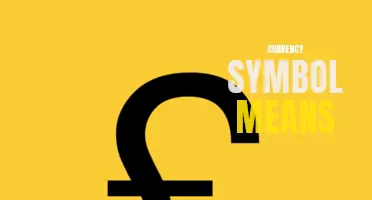
Have you ever wondered about the meaning behind the symbols that appear on your computer screen? From the familiar power button icon to the enigmatic ellipsis, these symbols hold a significant role in our digital lives. They convey messages without the need for words, and their meanings have become ingrained in our collective consciousness. In this article, we will explore the fascinating world of computer symbols and delve into their hidden meanings. So, get ready to decipher the language of icons and discover the stories they tell.
What You'll Learn
- What do common computer symbols, such as the power button or the Wi-Fi symbol, signify?
- How do computer symbols and icons help users understand and navigate software and operating systems?
- Is there a universal meaning behind computer symbols, or do they vary across different platforms and interfaces?
- Can the meaning of computer symbols change over time as technology and user interfaces evolve?
- How are computer symbols designed, and what factors are considered in their creation to ensure they are intuitive and easy to understand?

What do common computer symbols, such as the power button or the Wi-Fi symbol, signify?
Common computer symbols are used to represent various functions and features on devices such as computers, laptops, and smartphones. These symbols provide a visual representation of different actions and settings, making it easier for users to navigate and interact with their devices. Some of the most common computer symbols include the power button symbol, the Wi-Fi symbol, and the battery symbol, each of which signifies a specific meaning and function.
The power button symbol, typically represented as a circle with a vertical line inside it, is commonly found on computers and other electronic devices. This symbol represents the power on/off function of the device. Pressing the power button typically turns the device on or off, allowing users to control the power supply and overall functionality of their computers or other electronic devices.
The Wi-Fi symbol, often depicted as a series of curved lines emanating from a dot or a vertical rectangular shape, indicates the presence of a wireless network connection. When this symbol is visible on a computer or smartphone, it means that the device is connected to a Wi-Fi network, enabling users to access the internet and other online features. The strength of the Wi-Fi signal is usually represented by the number of curved lines or bars on the symbol.
The battery symbol, typically displayed as a rectangle with a lightning bolt inside it, represents the battery status and level on electronic devices. When this symbol is visible, it indicates the amount of battery power remaining on a device. A full battery symbol usually represents a fully charged battery, while a partially filled symbol suggests a partially depleted battery. When the battery is low, the symbol might change to a red color or show a warning sign, alerting users to recharge or connect their device to a power source.
In addition to these symbols, there are several other common computer symbols that convey different meanings and functions. For example, the keyboard symbol represents the input device used to enter text and commands on a computer. The monitor symbol represents the display screen of a computer or other electronic device. The speaker symbol represents the audio output or sound settings on a device. The USB symbol represents the Universal Serial Bus, which is used to connect peripherals such as external hard drives, keyboards, or mice to a computer.
Overall, common computer symbols play a vital role in user interface design, providing users with intuitive visual cues to understand and interact with various functions and features of their electronic devices. These symbols simplify the user experience, allowing individuals to navigate through different settings and actions without the need for extensive text or complex instructions. Understanding the meaning and significance of these symbols is essential for efficient and effective use of computers and other electronic devices in today's digital world.
Decoding the Symbols: A Guide to Understanding the Meaning Behind Waze's Symbols
You may want to see also

How do computer symbols and icons help users understand and navigate software and operating systems?
Computer symbols and icons play a crucial role in helping users understand and navigate software and operating systems. These visual representations simplify complex concepts, making them more accessible and intuitive to users.
One of the main advantages of symbols and icons is their universality. Unlike text-based instructions, symbols can be understood by people from different cultural backgrounds and with varying levels of literacy. For example, a magnifying glass icon is instantly recognizable as a tool for search or zooming in, regardless of the user's language or reading ability.
Symbols and icons also provide a quick and efficient way to convey important information within a limited amount of space. In software and operating systems, where there are countless functions and features, using symbols and icons allows for a more compact and streamlined user interface. Users can easily identify and access various commands and options without being overwhelmed by lengthy texts or descriptions.
Furthermore, symbols and icons facilitate the recognition and recall of information. Through repetition and consistency, users become familiar with the meaning behind different symbols, allowing them to navigate software and operating systems more efficiently over time. For example, the "Save" icon in the shape of a floppy disk is widely recognized as the symbol for saving files, even though using floppy disks is becoming increasingly rare in modern computing.
In addition to aiding navigation, symbols and icons contribute to the overall aesthetics and visual appeal of software and operating systems. Well-designed icons can enhance the user experience, create a cohesive visual language, and make the interface more visually engaging. This aspect is particularly important as users are more likely to engage with software and operating systems that are visually pleasing and intuitive to use.
However, it is important for designers to ensure that symbols and icons are clear, meaningful, and easy to interpret. Poorly designed or ambiguous icons can confuse users, leading to frustration and reduced efficiency. Conducting user testing and gathering feedback from target users can help identify any issues and improve the design and usability of symbols and icons.
In conclusion, computer symbols and icons greatly assist users in understanding and navigating software and operating systems. They provide a universal language, simplify complex concepts, save space, aid recognition and recall, contribute to aesthetics, and enhance the overall user experience. By incorporating well-designed symbols and icons, software and operating systems can be more user-friendly and accessible to a wide range of individuals.
Understanding Nissan Maxima Dashboard Symbols and Their Meanings
You may want to see also

Is there a universal meaning behind computer symbols, or do they vary across different platforms and interfaces?
When it comes to using computers and digital devices, symbols play a crucial role in helping users navigate through different functions and features. From simple icons like arrows and magnifying glasses to more complex symbols like the power button or the Wi-Fi signal indicator, these symbols serve as visual cues that convey specific meanings. However, the interpretation and understanding of these symbols can vary across different platforms and interfaces.
In today's digital landscape, there is no universal set of symbols that can be applied consistently across all devices and interfaces. The design of symbols often depends on the operating system, software, or app being used. As a result, symbols that represent the same function may look different on a Windows PC, a Mac, an iPhone, or an Android device.
One reason behind the variation in symbol design is the artistic preferences and branding choices of different companies and developers. For example, the power symbol on a Mac appears as a simple circle with a line in the middle, while on a Windows PC, it is represented as a vertical line intersecting a horizontal line forming a square. These design differences may be subtle, but they can cause confusion for users, especially when transitioning between different platforms.
Another factor contributing to the inconsistency in symbol meanings is cultural differences. Some symbols may have different interpretations in different parts of the world. For instance, the thumbs-up gesture is commonly associated with approval and positivity in many Western cultures. However, in some Middle Eastern countries, this gesture is considered offensive and derogatory. Similarly, symbols like the checkmark and the cross can have different connotations depending on the context and cultural background.
Furthermore, the rapid evolution of technology and the introduction of new features often lead to the creation of unique symbols that may not have established meanings. For example, the rise of social media platforms has given birth to symbols like the "retweet" and the "like" button, which did not exist before. In such cases, the meaning of these symbols is typically communicated through the platform's interface design, tooltips, or user guides.
To navigate the ambiguity and potential confusion caused by varying symbol meanings, developers and designers must prioritize usability and user experience. Consistency within an interface and clear visual cues can greatly enhance the user's ability to understand and interact with symbols effectively. Providing tooltips or descriptive text alongside symbols can also help clarify their meanings and minimize any confusion.
In conclusion, while symbols are an essential component of computer interfaces, their meanings are not universally standardized. Design choices, cultural differences, and the constantly evolving nature of technology all contribute to the variation in symbol interpretations across platforms and interfaces. To ensure a seamless user experience, designers must focus on creating intuitive and consistent symbol designs while providing clear explanations and visual cues to assist users in understanding their meanings.
Unravel the Enigma: Match the Dynamic Symbol to Its Corresponding Meaning
You may want to see also

Can the meaning of computer symbols change over time as technology and user interfaces evolve?
Symbols are an essential part of computer interfaces. They help users navigate through various functions and operations without the need for lengthy explanations or instructions. However, these symbols aren't static and unchanging; they can evolve and change their meaning as technology and user interfaces progress.
One of the most prominent examples of changing symbol meanings is the floppy disk icon used to represent the save function in many software applications. The floppy disk symbol was widely used in the 1980s and 1990s when actual floppy disks were the primary means of storing data. However, as technology advanced, floppy disks became obsolete, and many users today may have never actually used or even seen a floppy disk. Yet, the symbol remains prevalent and is still universally recognized as the save icon, despite its diminishing relevance and connection to the physical world.
Another example is the "hamburger menu" symbol, consisting of three stacked horizontal lines, used to indicate a menu of options in mobile apps. This symbol gained popularity in the early 2010s with the rise of responsive design and the need for more compact and intuitive user interfaces. However, as touchscreens became more prevalent, many newer users may not make the connection between the symbol and a traditional menu. Instead, they may see it as a stack of lines without any inherent meaning. This has led to some debate about the usability and effectiveness of the symbol, with suggestions for alternative, more universal icons to represent menus.
The evolution of symbols in user interfaces is driven by several factors. Technological advancements often render traditional symbols obsolete or less relevant. For example, the rise of touchscreen devices and the decline of physical buttons have led to new symbols and gestures to represent actions like zooming or scrolling. Moreover, the increasing global nature of technology means that symbols need to be understandable and recognizable across different cultures and languages. This has led to the creation of more universal symbols, such as the power symbol (a circle with a line), which transcends language barriers.
The meaning of symbols can also change due to changes in user habits and expectations. As we become more familiar with technology and its conventions, symbols that were once cryptic or unfamiliar may become second nature. For example, the "@" symbol was initially used mainly in email addresses, but with the rise of social media and messaging apps, it has become more widely recognized as a symbol for mentions or tagging other users.
In conclusion, computer symbols can indeed change their meaning over time as technology and user interfaces evolve. Technological advancements, changing user habits, and the need for universal symbols all contribute to this evolution. As new interfaces and technologies emerge, it is crucial for designers to reassess the relevance and effectiveness of symbols to ensure they remain intuitive and communicative to users.
Understanding the Symbols and Meanings on Yamaha Tach Gauges
You may want to see also

How are computer symbols designed, and what factors are considered in their creation to ensure they are intuitive and easy to understand?
Computer symbols are an essential part of our digital lives. They provide us with a visual representation of various functions, commands, and actions within computer systems. From the power button symbol to the save icon, these symbols play a crucial role in guiding us through our interactions with computers. But have you ever wondered how computer symbols are designed and what factors are considered in their creation to ensure they are intuitive and easy to understand? In this article, we will explore the process behind designing computer symbols and the key considerations taken into account.
When it comes to designing computer symbols, there are several factors that designers take into consideration. The first and foremost consideration is universality. Computer symbols need to be universally understandable across different cultures, languages, and backgrounds. This means that designers strive to create symbols that can be easily recognized and understood by a global audience. For example, the power button symbol, a simple circle with a vertical line, is universally recognized as the symbol to turn a device on or off.
Another crucial factor in symbol design is simplicity. Computer symbols need to be concise and easy to process at a glance. In an age where attention spans are short and users expect instant comprehension, designers aim for simplicity in their symbol designs. Complex or intricate symbols can confuse users and detract from the user experience. Therefore, designers often strip symbols down to their most basic forms, using simple geometric shapes and lines to convey meaning. The simplicity of computer symbols allows users to quickly identify and understand their purpose.
Consistency is also an important consideration in symbol design. Designers strive to establish a cohesive visual language across different symbols and applications. This consistency allows users to easily transfer their knowledge from one symbol to another, making their overall experience more seamless. For example, the save icon, typically represented by a floppy disk, has become a standard symbol for saving files across various software applications. This consistency creates a sense of familiarity and reduces the learning curve when using different programs.
In addition to universality, simplicity, and consistency, designers also consider cultural and contextual factors when creating computer symbols. Different cultures may interpret symbols differently, so designers need to be mindful of these cultural nuances. Context is also crucial in symbol design, as symbols may have different meanings depending on the context in which they are used. For example, the magnifying glass symbol is universally recognized as a search function, but its exact functionality may vary depending on the specific application or system.
To ensure the effectiveness and intuitiveness of computer symbols, designers often conduct user testing and feedback collection. By observing how users interact with symbols and gathering feedback, designers can refine and improve their designs. This iterative process helps to eliminate any ambiguities or confusion, ultimately resulting in symbols that are intuitive and easy to understand.
In conclusion, computer symbols are meticulously designed to be intuitive and easy to understand. Designers consider factors such as universality, simplicity, consistency, cultural nuances, and context to create symbols that can be universally recognized. Through user testing and feedback collection, designers continuously refine their designs to ensure optimum usability. So, the next time you interact with a computer symbol, remember the thought and consideration that went into its creation. These symbols are the silent guides in our digital journey, helping us navigate effortlessly through the complex world of technology.
Decoding the Red Lightning Bolt: Understanding Jeep Dashboard Symbols
You may want to see also
Frequently asked questions
The power symbol on a computer typically represents the power button. Pressing this button will turn the computer on or off. It is usually a circle with a vertical line inside.
The Wi-Fi symbol on a computer indicates that the device is connected to a wireless network. This symbol is typically represented by a series of curved lines or waves.
The battery symbol on a computer represents the amount of battery life left on a laptop or mobile device. This symbol is usually shown as a battery icon with a percentage next to it, indicating the remaining battery power.
The keyboard symbol on a computer represents the input device used to type and enter commands. This symbol typically looks like a set of keys or a box with letters and numbers inside.







